by Carol A Westbrook
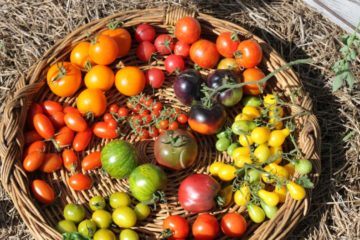
Summer is finally here, and nothing says “summer” more than biting into a sweet, ripe freshly-picked tomato, still warm from the sun, eaten with a pinch of salt. The variety of tomatoes is incredible; from sweet 1-pound beefsteaks, delicious eaten raw, to plum tomatoes for canning and sauces, to colorful cheery cherry tomatoes, adding a spot of color to salads and crudities.
Even green tomatoes, stubbornly refusing to ripen at the end of the season, have a use in salsa, or simply or breaded and fried.
The best way to a sweet tomato is to grow your own. I have fond memories of my father’s garden patch in our Chicago yard, where he tended about a dozen tomato plants of several varieties. On warm days in late August I’d walk through the garden with a saltshaker, pick a perfectly ripe tomato, shake on some salt, and dig in, sweet warm tomato juice dripping down my chin. We four kids pitched in, tilling the soil, setting out the plants, weeding, and keeping an eye out for those plump, ugly, disgusting caterpillars, that could devour an entire tomato vine in a matter of hours!
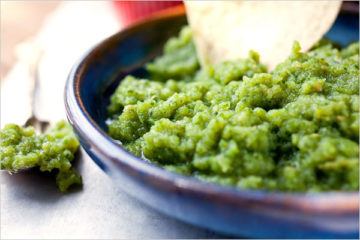
The season for growing tomatoes is short in Chicago, lasting only about 4 months, from early June to mid-September. At season’s end you will find delicious tomatoes in farmers’ markets, get them from friends, or pick them from your garden. The rest of the year you have to put up with tasteless store-bought tomatoes. The only thing to be said for them is that they look like tomatoes and ship well.
When I was a child, supermarket tomatoes were sweet and delicious, but that all changed over the last 50 years when commercial producers began to grow tomatoes that ripened uniformly in size and color, held up well to shipping, and grew on plants that were disease-resistant. It was believed that the plant breeders concentrated more on the looks and ship-ability of the tomatoes than on their taste, though breeders would have liked to preserve the sweet tomato flavor as well. But it just seemed that when the breeders got the perfect, beautiful, easy-to-ship red tomato that that flavor would disappear.

Why perfect supermarket tomatoes had no flavor was only recently understood, as plant geneticists identified some of the genes that contributed to good flavor. Two groups of scientists, one at Cornel at the other at UC Davis, independently discovered that the gene for flavor is the same gene that causes “green shoulders” in tomatoes (see picture, above). These green shoulders—residual green color near the stem on the top of the tomato–may be unsightly, and make the tomato look less than ripe, but they allow the fruit to absorb more light as it ripens, which in turn promotes the continued synthesis of sugar in the fruit, loading it with flavor and sweetness as it nears maturity. So having a perfectly uniform red tomato and a sweet, tasty tomato can be mutually exclusive. As Sam Dean, writing for Bon Apetite said, “it’s hard to believe that we’ve choked down 50 years of crappy tomatoes for the sake of redness.”
Tomato researchers have learned from this that having a lot of direct sunlight is the most important factor in producing flavorful tomatoes. This also explains why hothouse supermarket tomatoes seem even more tasteless than field-grown, supermarket tomatoes: less light reaches the plant when grown under glass. So perhaps tomato scientists will find another way to develop tomatoes that are suitable for large-scale production and shipping that retain their flavor.
No one will deny that home-grown tomatoes are the tastiest. But growing tomatoes at home is a lot of work. Because the season is so short here in Chicago, we have to start seeds indoors well before the growing season in order to put established young plants in the ground after all danger of frost is over—Dad always said after Memorial Day. (Tomatoes can’t grow in temperatures below 55°, and they don’t thrive with cool nights). In season, you can buy young tomato plants at any nursery or home improvement store, or grow your young plants from seeds on your windowsill, like Dad did.
This year I thought I would give it a try. This would give me an opportunity to try some new varieties and heirlooms, and to finally have some flavorful tomatoes. So in mid-March I started my tomato plants from seeds, indoors, under plant lights. It proved to be a perfect indoor project for me when Covid rates rose and another lockdown was imposed.
I set up a 2×4 foot cart next to a window in a sunny room, supplementing the sunlight with grow-lights. In choosing lights, it’s important to use the correct lighting for these demanding plants, to insure proper growth. Tomatoes need at least 6 hours of direct sunlight. Indirect or dappled sunlight is will keep the plants alive, but they will be stunted and likely not produce much fruit. It’s also important to get a balanced spectrum that mimics sunlight. For the best color balance, you can use fluorescent shop lights, combining one “cool white” and one “warm white” to get a light spectrum that is close to sunlight; or you can use LED Grow lights, which provide brighter balanced lights, and which don’t need special fluorescent fixtures (but are more expensive.) I purchased two plant lights from Amazon.: GHodec TS 500 LED Grow Light, 5000K Sunlike Full Spectrum Plant Lamp, and put them on a timer, providing 14 hours of bright light each day. The combination of blue and red LEDs in these lights gives an eerie purple glow to the room.
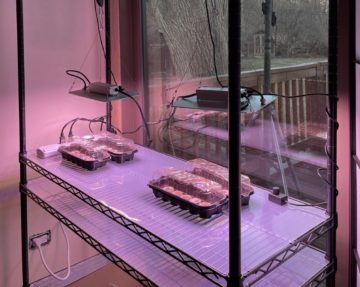
I also promised to grow tomato plants for other friends and family. My sister, an avid indoor gardener, was an expert at growing flowering plants and orchids. She wanted to try to grow her tomatoes indoors, under lights. My daughter, who would be visiting from Pittsburgh, planned to take a few plants home in her car to grow in raised flower beds. She was hoping to avoid staking the plants as they grew older and leggier. For ours, there were two sites; first, we created a small tomato patch in a sunny sport of the yard of our city house, and into half-barrel planters on the deck of our other house. As the plants grew taller, we would tie them to stakes for support The only requirement is that all sites had full sun for most of the day. Tomato plants do not grow well in the shade.
So we needed miniature plants for my sister, bush plants suitable for containers for my daughter, and full-size plants for our other sites. For seeds, I turned to Burpee’s, a seed company that has been around a long time. I remember my family getting our catalog by mail every spring. I had been enthralled by the beautiful color pictures and the selections of seeds and plants, especially the new Burpee varieties with their clever names, like their Queen of the Night black tulip and their Easy Peasy peas. Burpee also delivered quality seeds with high rates of germination, and was especially noted for its successful hybrids in many types of plant, from tulips to tomatoes. In fact, Burpee introduced the first tomato hybrid that was commercially available, in 1945, called the Burpee Hybrid.
Burpee’s second tomato hybrid, Big Boy, introduced in 1949, was so vigorous that it is considered to be the variant that ushered in the era of modern tomato hybrids. In general, the parentage of successful hybrids is a closely kept secret, but Big Boy is thought to be bred from a variety called Teddy Jones and an unknown Ukranian heirloom. Teddy Jones is also a parent of Better Boy, a Burpee variant that is larger and more productive than Big Boy. Better Boy holds the Guinness record for most tomatoes produced by a single plant. Seeds for Teddy Jones have so far been unavailable, as many blogs for tomato afficianados will report. But the search for heirlooms is a story for another day. So I began my selections from the Burpee web site, including both heirloom and hybrid varieties of tomatoes.
Before I go further, I’d like to set the record straight on hybrids. Many people believe that all heirloom tomatoes are ugly but good-tasting, while hybrids are beautiful, perfectly round and tasteless. This is not true at all. Though it is true that most of the continuously cultivated heirlooms are tasty—which is why they continue to be cultivated— most hybrids that are available to home growers are just as delicious. That is one of the appeals of hybrid seeds; for example, Better Boy is noted for its delicious taste, while some cherry tomato hybrids are among the sweetest available; wait until you taste Sweetheart of the Patio from my garden later this summer! In general, it is only the hybrid tomatoes that are bred for commercial production, with uniformity of size and ripeness, vigorous grown that bruise-free shipping, that have lost their good taste. These are generally not the ones on offer to the home grower.
From the perspective of genetics, there are only two kinds of tomatoes, hybrids and non-hybrids. Heirloom tomatoes are non-hybrids also called “open pollinated.” These variants breed true. In other words, if you collect and plant the seeds from a true heirloom tomato, it will grow the same heirloom variety as its parent. Hybrids are created by crossing two heirlooms to produce a hybrid variety. Seeds from hybrids are likely to be sterile or, if they do germinate, they will not give the same variety of plant from which they were created, or a weak plant that does not bear fruit. Hybrids are like mules, which are the result of a cross between a male donkey and a female horse. Mules cannot reproduce because they are hybrids; the same is true for hybrid tomatoes.
Producing new varieties of plants by cross pollination is a technique that has been around for millenia–probably since the start of farming in the Fertile Crescent. Burpee scientists pollinate one heirloom variety of tomato with the pollen from another heirloom variety to produce seeds that will grow into a new, hybrid variety which hopefully will contain the desired characteristics of the parent varieties. The seed catalogs—paper or online—will give accurate descriptions of these varieties, and tell you whether they are heirlooms or hybrids. Burpee, and most other reputable seed companies will not sell genetically modified seeds.
I made my selection of a about dozen plants. I picked out four cherry tomatoes: Chadwick Cherry is an heirloom, favored for its disease resistance and vigorous growth; Supersweet 100 is a hybrid which produces long, branched clusters of deliciously sweet cherry tomatoes with a high sugar content; Sweetheart of the Patio is a small hybrid with cascading branches full of super-sweet grape tomatoes, Veranda Red is a dwarf plant which requires only 1 sq ft of space!
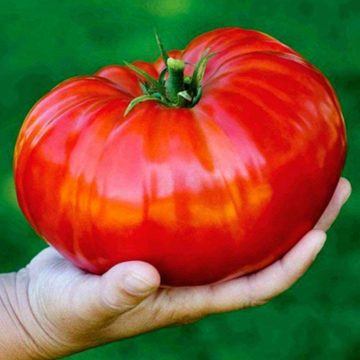
For full-size and beefsteak tomatoes, I selected both heirlooms and hybrids. The heirlooms were Bloody Butcher, which produces very early 2” tomatoes; Druzba, originally from Bulgaria, noted for its productivity, which delivers a very flavorful small beefsteak; Quarter Century, which produces oblate half-pound, mild-flavored beefsteaks. For hybrid plants with larger fruits, Bushsteak, only 2 feet tall, is a dwarf tomato plant that produces half-pound beefsteak tomatoes; Atlas, only about 3 feet tall, grows very large beefsteak tomatoes on a small plant. And finally, that reliable workhorse, Early Girl and a new variant, Bush Early Girl, with a growth pattern that is suitable for containers. Note that none of these varieties are genetically-modified.
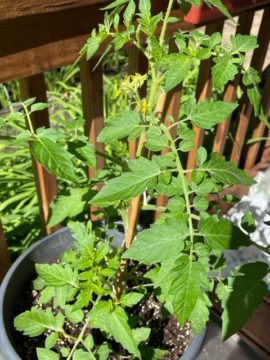
I set seeds out in peat seed-pod plants, putting 1 to 3 seeds in each pod, and set them under the lights. They began to germinate, and already I could see the differences. Early Girl and Chadwick Cherry germinated in about a week, while most of the others took 2 weeks before little shoots poked out above the dirt. When most of the plants were about 2 inches tall, I put them into 4” pots to grow under lights. In early May, I put the pots outside into a raised bed to harden and get used to the climate; that means temperatures in the 50’s to 80’s, sunny and overcast days, and driving storms on occasion.
Last week we transplanted the plants into the outside gardens, or larger pots. My Chadwick Cherry thanked me by immediately putting out blossoms! (See

above). My husband and I made chickenwire “bird cages” to put around the plants to keep the birds out. (Below, on the right). Now we will just have to wait and watch them grow. I am looking forward to seeing the variety in the sizes and tastes of the fruits, and the growth and vigor of the plants. You will have to wait until fall, when the days get short and the average temperature fall to the 50’s, to get an update on this story, and see how the Tomato Project turned out.
